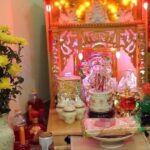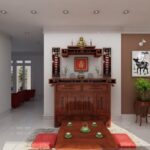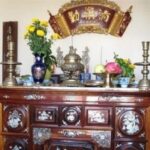In Vietnamese worship culture, every detail on the altar holds profound spiritual significance. Some families nowadays, observing the use of circular incense holders at temples and pagodas for a grander display, have adopted this practice in their home altars. However, according to feng shui beliefs and traditional folk culture, this is something to be avoided. Let’s explore why circular incense holders from temples and pagodas are not suitable for home ancestor altars.
1. What is a circular incense holder?
A circular incense holder is a metal stand, typically made of iron or copper, with a curved top or a hook to hang circular incense coils. This type of stand is usually placed in the center of the incense burner or fixed within the incense burner in public worship places like temples, shrines, and ancestral halls.
Using a metal stand allows the incense to burn longer, continuously diffusing fragrance in large spaces such as the main hall or areas dedicated to the worship of Buddha, saints, or deities.
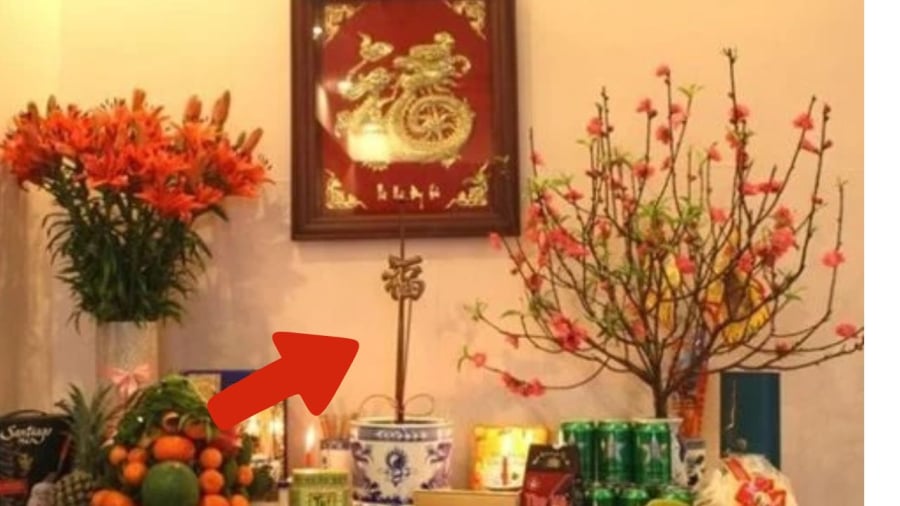
2. Inappropriate for home ancestor altars
Home ancestor altars hold a special meaning, honoring the memory of one’s ancestors and family elders. They are private and intimate spaces for worship. Using an iron circular incense holder placed in the incense burner—a common sight in religious institutions—is considered inappropriate for home ancestor altars as it does not align with traditional norms. Ancestor worship is about venerating the souls of one’s lineage, and the spiritual practices differ from those associated with deities, Buddha, or saints.
3. Inserting metal into the incense burner—a spiritual taboo
According to feng shui and folk beliefs, the incense burner is a sacred space where ancestors and deities reside. Any items placed within it should be carefully selected, typically including clean ash and, if applicable, incense burner cores and incense sticks.
Inserting a metal rod (the circular incense holder) into the incense burner is believed to disrupt the spiritual energy, affecting the family’s peace and prosperity. For this reason, many feng shui masters and experienced worshippers strongly advise against placing foreign objects, especially metal ones, into the incense burner on home ancestor altars.
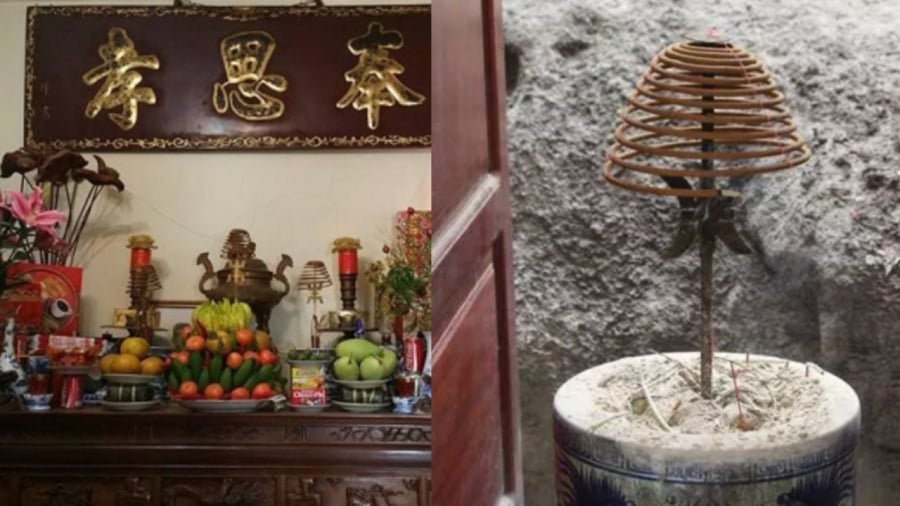
4. Differences in worship practices between homes and temples
Temples and shrines are places dedicated to the worship of Buddha and various deities, with solemn rituals and frequent offerings of large amounts of incense. Thus, the use of circular incense holders to prolong the burning of incense coils is understandable. However, family worship usually takes place on specific occasions (the first and fifteenth of the lunar month, death anniversaries, etc.) and on a smaller scale, rendering such bulky stands unnecessary.
Additionally, home ancestor altars are typically designed to be compact, and traditional straight incense sticks are more suitable and aesthetically pleasing. Adding a circular incense holder to the burner can disrupt the balance and beauty of the altar, detracting from the refined nature of the family worship space.
5. Safety and hygiene concerns
Circular incense holders are often used with long-burning incense coils, producing excessive smoke and ash, which can stain the ceiling, settle on ancestral photos and worship items, and affect indoor air quality. Improper hanging of the incense coil or a falling incense stick can pose a fire hazard, especially in the confined space of a home altar.
Using circular incense holders and long-burning incense coils in homes is therefore unsafe and inconvenient for cleaning, not to mention the potential impact on indoor air quality.
6. Recommended incense for home ancestor altars
To uphold traditional norms and solemnity, it is advisable to use the following types of incense on home ancestor altars:
- Straight incense sticks (commonly available, free from chemical additives, and made from aromatic materials such as agarwood, cinnamon, or fragrant wood)
- Incense stick length can vary depending on the worship space; shorter sticks are suitable for altars close to the ceiling, for example.
- Light one or three incense sticks at a time, depending on regional customs.
- Avoid excessive incense, which can create a stuffy or unpleasant atmosphere.
- Refrain from placing foreign objects, especially metal ones, into the incense burner, as it is considered a major taboo.
Ancestor worship is a beautiful tradition in Vietnamese culture, expressing reverence and gratitude toward one’s roots. Careful consideration should be given to altar arrangement, choice of incense, and accompanying tools to ensure adherence to ritual, spiritual, and cultural norms. Using circular incense holders like those in temples is inappropriate for home ancestor altars, as it not only clashes with the space but also violates spiritual principles, posing unnecessary risks.
Let’s maintain a clean and serene worship space at home, reflecting our sincere devotion to our ancestors.
Reference for spiritual contemplation
The Things You Should Never Place on an Ancestral Altar
The ancestral altar is a sacred spiritual corner in the home, a space for offering gratitude and respect to one’s ancestors. According to traditional feng shui, the placement of objects on the altar is of utmost importance, as even a slight misstep can disrupt the harmony of the home and impact family dynamics and fortune.
Where Should the Flower Vase Be Placed on the Ancestral Altar: Left or Right? Many Families Are Doing It Wrong and Losing Their Luck.
“Arranging an altar can be a daunting task, especially when it comes to the placement of the flower vase – a small yet spiritually significant item. Many are unsure of the optimal layout for their altar, seeking a setup that not only looks pleasing but also aligns with Feng Shui principles. The vase’s position, though seemingly minor, holds a profound influence on the overall energy and harmony of the space.”

























